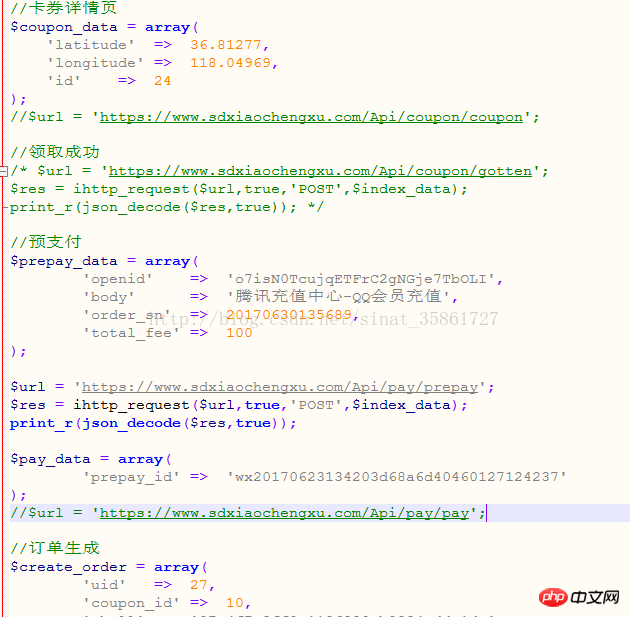PHP进行API接口测试
最近写API接口,每写一个接口,我自己需要先测试一下,看有没有语法错误,请求的数据对不对,但是很多都是POST请求,没法直接在浏览器中打开链接进行测试,所以必须要有个可以在本地发HTTP请求的模拟工具,模拟一下数据请求。
一开始我是这么干的,在本机wampserver运行目录下创建一个文件,在里边写Curl请求,进行模拟请求测试,但是每个接口需要的参数都不一样,我需要不断地修改请求的参数和API,很是不方便。到后来我的这个请求文件里边乱糟糟的数据,我都分不清了:
在网上找了找相关的工具,有不少在线测试的,比如:ATOOL在线工具、Apizza等等,看了下他们做的都很好,使用非常方便,界面很漂亮,服务也很周到。但是我在考虑安全问题,同时它给我返回的是原始的JSON格式的数据,我习惯于看数组格式的,比较直观。
于是乎,本着自己动手丰衣足食的理念,我就在本地写一个简易的API测试页面,提交数据之后在本地实现API请求测试功能,既不用考虑安全问题,又可以对结果随便转换。只需要两个文件就搞定,一个是填写数据的页面post.html,另一个是接收post.html页面传过来的数据并处理请求实现功能的post.php文件。
1.前端页面文件post.html

只是是简易的页面,没有复杂的布局,没有JS特效,暂时只写了6个参数,一般来说也够了,不够的可以自行添加。这里默认传的都是body请求参数,请求方式也只使用了GET和POST。
<html xmlns="http://blog.csdn.net/sinat_35861727?viewmode=contents">
<head>
<meta http-equiv = "Content-Type" content = "text/html;charset = utf8">
<meta name = "description" content = "提交表单">
<title>API接口请求表单</title>
</head>
<style type="text/css">
.key1{
width:100px;
}
.value1{
width:230px;
margin:0 0 0 10px;
}
.main{
margin:0 auto;
width:450px;
height:auto;
background:lightgray;
padding:40px 40px;
}
.refer{
width:100px;
height:24px;
}
.url{
width:350px;
}
</style>
<body>
<p class="main">
<form method="POST" action="post.php" target="_blank">
<p>请求地址:<input class="url" type="text" name="curl" placeholder="API接口地址"></p>
<p>参 数1: <input class="key1" type="text" name="key1" placeholder="参数名">
<input class="value1" type="text" name="value1" placeholder="参数值"></p>
<p>参 数2: <input class="key1" type="text" name="key2" placeholder="参数名">
<input class="value1" type="text" name="value2" placeholder="参数值"></p>
<p>参 数3: <input class="key1" type="text" name="key3" placeholder="参数名">
<input class="value1" type="text" name="value3" placeholder="参数值"></p>
<p>参 数4: <input class="key1" type="text" name="key4" placeholder="参数名">
<input class="value1" type="text" name="value4" placeholder="参数值"></p>
<p>参 数5: <input class="key1" type="text" name="key5" placeholder="参数名">
<input class="value1" type="text" name="value5" placeholder="参数值"></p>
<p>参 数6: <input class="key1" type="text" name="key6" placeholder="参数名">
<input class="value1" type="text" name="value6" placeholder="参数值"></p>
<p>请求方式: <select name="method">
<option value="POST">POST请求</option>
<option value="GET">GET请求</option>
</select></p>
<p style="text-align:center;"><input class="refer" type="submit" value="提交"></p>
</form>
</p>
</body>
</html>
2.数据处理文件post.php
接收post.html页面传过来的数据,并发送请求然后处理请求结果,前端页面传过来的都是Body请求参数,如果还需要Header参数的话,可以在这个文件手动添加上去。
<?php
echo '<title>API接口请求响应</title>';
/**
* 设置网络请求配置
* @param [string] $curl 请求的URL
* @param [bool] true || false 是否https请求
* @param [string] $method 请求方式,默认GET
* @param [array] $header 请求的header参数
* @param [object] $data PUT请求的时候发送的数据对象
* @return [object] 返回请求响应
*/
function ihttp_request($curl,$https=true,$method='GET',$header=array(),$data=null){
// 创建一个新cURL资源
$ch = curl_init();
// 设置URL和相应的选项
curl_setopt($ch, CURLOPT_URL, $curl); //要访问的网站
//curl_setopt($ch, CURLOPT_HEADER, false);
curl_setopt($ch, CURLOPT_HTTPHEADER, $header);
curl_setopt($ch, CURLOPT_RETURNTRANSFER, true);
if($https){
curl_setopt($ch, CURLOPT_SSL_VERIFYPEER, false);
//curl_setopt($ch, CURLOPT_SSL_VERIFYHOST, true);
}
if($method == 'POST'){
curl_setopt($ch, CURLOPT_POST, true); //发送 POST 请求
curl_setopt($ch, CURLOPT_POSTFIELDS, $data);
}
// 抓取URL并把它传递给浏览器
$content = curl_exec($ch);
if ($content === false) {
return "网络请求出错: " . curl_error($ch);
exit();
}
//关闭cURL资源,并且释放系统资源
curl_close($ch);
return $content;
}
//检查是否是链接格式
function checkUrl($C_url){
$str="/^http(s?):\/\/(?:[A-za-z0-9-]+\.)+[A-za-z]{2,4}(?:[\/\?#][\/=\?%\-&~`@[\]\':+!\.#\w]*)?$/";
if (!preg_match($str,$C_url)){
return false;
}else{
return true;
}
}
//检查是不是HTTPS
function check_https($url){
$str="/^https:/";
if (!preg_match($str,$url)){
return false;
}else{
return true;
}
}
if($_SERVER['REQUEST_METHOD'] != 'POST') exit('请求方式错误!');
//发送请求
function curl_query(){
$data = array(
$_POST['key1'] => $_POST['value1'],
$_POST['key2'] => $_POST['value2'],
$_POST['key3'] => $_POST['value3'],
$_POST['key4'] => $_POST['value4'],
$_POST['key5'] => $_POST['value5'],
$_POST['key6'] => $_POST['value6']
);
//数组去空
$data = array_filter($data); //post请求的参数
if(empty($data)) exit('请填写参数');
$url = $_POST['curl']; //API接口
if(!checkUrl($url)) exit('链接格式错误'); //检查连接的格式
$is_https = check_https($url); //是否是HTTPS请求
$method = $_POST['method']; //请求方式(GET POST)
$header = array(); //携带header参数
//$header[] = 'Cache-Control: max-age=0';
//$header[] = 'Connection: keep-alive';
if($method == 'POST'){
$res = ihttp_request($url,$is_https,$method,$header,$data);
print_r(json_decode($res,true));
}else if($method == 'GET'){
$curl = $url.'?'.http_build_query($data); //GET请求参数拼接
$res = ihttp_request($curl,$is_https,$method,$header);
print_r(json_decode($res,true));
}else{
exit('error request method');
}
}
curl_query();
?>写的很简单,功能也不是很全面,正常情况下的POST和GET请求还是可以满足的,至少本地测试查看结果是没有问题的,有需要的小伙伴可下载代码下来,然后根据自己的需求自行修改完善功能。
相关推荐:
以上是PHP进行API接口测试的详细内容。更多信息请关注PHP中文网其他相关文章!

热AI工具

Undresser.AI Undress
人工智能驱动的应用程序,用于创建逼真的裸体照片

AI Clothes Remover
用于从照片中去除衣服的在线人工智能工具。

Undress AI Tool
免费脱衣服图片

Clothoff.io
AI脱衣机

AI Hentai Generator
免费生成ai无尽的。

热门文章

热工具

记事本++7.3.1
好用且免费的代码编辑器

SublimeText3汉化版
中文版,非常好用

禅工作室 13.0.1
功能强大的PHP集成开发环境

Dreamweaver CS6
视觉化网页开发工具

SublimeText3 Mac版
神级代码编辑软件(SublimeText3)

热门话题
 适用于 Ubuntu 和 Debian 的 PHP 8.4 安装和升级指南
Dec 24, 2024 pm 04:42 PM
适用于 Ubuntu 和 Debian 的 PHP 8.4 安装和升级指南
Dec 24, 2024 pm 04:42 PM
PHP 8.4 带来了多项新功能、安全性改进和性能改进,同时弃用和删除了大量功能。 本指南介绍了如何在 Ubuntu、Debian 或其衍生版本上安装 PHP 8.4 或升级到 PHP 8.4
 如何设置 Visual Studio Code (VS Code) 进行 PHP 开发
Dec 20, 2024 am 11:31 AM
如何设置 Visual Studio Code (VS Code) 进行 PHP 开发
Dec 20, 2024 am 11:31 AM
Visual Studio Code,也称为 VS Code,是一个免费的源代码编辑器 - 或集成开发环境 (IDE) - 可用于所有主要操作系统。 VS Code 拥有针对多种编程语言的大量扩展,可以轻松编写
 我后悔之前不知道的 7 个 PHP 函数
Nov 13, 2024 am 09:42 AM
我后悔之前不知道的 7 个 PHP 函数
Nov 13, 2024 am 09:42 AM
如果您是一位经验丰富的 PHP 开发人员,您可能会感觉您已经在那里并且已经完成了。您已经开发了大量的应用程序,调试了数百万行代码,并调整了一堆脚本来实现操作
 您如何在PHP中解析和处理HTML/XML?
Feb 07, 2025 am 11:57 AM
您如何在PHP中解析和处理HTML/XML?
Feb 07, 2025 am 11:57 AM
本教程演示了如何使用PHP有效地处理XML文档。 XML(可扩展的标记语言)是一种用于人类可读性和机器解析的多功能文本标记语言。它通常用于数据存储
 在PHP API中说明JSON Web令牌(JWT)及其用例。
Apr 05, 2025 am 12:04 AM
在PHP API中说明JSON Web令牌(JWT)及其用例。
Apr 05, 2025 am 12:04 AM
JWT是一种基于JSON的开放标准,用于在各方之间安全地传输信息,主要用于身份验证和信息交换。1.JWT由Header、Payload和Signature三部分组成。2.JWT的工作原理包括生成JWT、验证JWT和解析Payload三个步骤。3.在PHP中使用JWT进行身份验证时,可以生成和验证JWT,并在高级用法中包含用户角色和权限信息。4.常见错误包括签名验证失败、令牌过期和Payload过大,调试技巧包括使用调试工具和日志记录。5.性能优化和最佳实践包括使用合适的签名算法、合理设置有效期、
 php程序在字符串中计数元音
Feb 07, 2025 pm 12:12 PM
php程序在字符串中计数元音
Feb 07, 2025 pm 12:12 PM
字符串是由字符组成的序列,包括字母、数字和符号。本教程将学习如何使用不同的方法在PHP中计算给定字符串中元音的数量。英语中的元音是a、e、i、o、u,它们可以是大写或小写。 什么是元音? 元音是代表特定语音的字母字符。英语中共有五个元音,包括大写和小写: a, e, i, o, u 示例 1 输入:字符串 = "Tutorialspoint" 输出:6 解释 字符串 "Tutorialspoint" 中的元音是 u、o、i、a、o、i。总共有 6 个元
 解释PHP中的晚期静态绑定(静态::)。
Apr 03, 2025 am 12:04 AM
解释PHP中的晚期静态绑定(静态::)。
Apr 03, 2025 am 12:04 AM
静态绑定(static::)在PHP中实现晚期静态绑定(LSB),允许在静态上下文中引用调用类而非定义类。1)解析过程在运行时进行,2)在继承关系中向上查找调用类,3)可能带来性能开销。
 什么是PHP魔术方法(__ -construct,__destruct,__call,__get,__ set等)并提供用例?
Apr 03, 2025 am 12:03 AM
什么是PHP魔术方法(__ -construct,__destruct,__call,__get,__ set等)并提供用例?
Apr 03, 2025 am 12:03 AM
PHP的魔法方法有哪些?PHP的魔法方法包括:1.\_\_construct,用于初始化对象;2.\_\_destruct,用于清理资源;3.\_\_call,处理不存在的方法调用;4.\_\_get,实现动态属性访问;5.\_\_set,实现动态属性设置。这些方法在特定情况下自动调用,提升代码的灵活性和效率。






